Moving from a traditional SaaS to a pure consumption model was a challenging but fun transition for MongoDB.
At a recent Workshop Wednesday, held every Wednesday at 10 a.m, Meghan Gill, SVP of Sales Ops and Sales Dev at MongoDB, shares different consumption-based compensation models that drive the right behaviors.
A Story About A Cobra
Before talking about what consumption means today, Meghan shared a fable.
Once upon a time, there was a village with a cobra problem. There were too many cobras, and they were a menace. So, the mayor told the village he would pay them a dollar for every cobra killed to get things under control. It didn’t work. Instead, people started breeding cobras and killing them in order to collect their bounty.
The moral of the story?
You have to think about what behavior you’re trying to drive. Compensation will drive it and have unexpected results. If you want to get rid of the cobras, paying for every cobra killed clearly wasn’t the right behavior to compensate.
What Is A “Consumption” Business
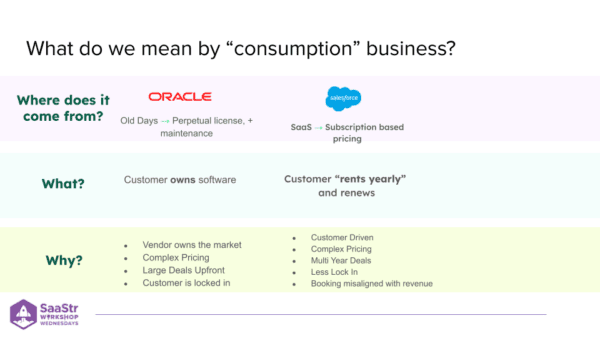
In the old days of software, you had a company like Oracle that popularized the perpetual license where customers own the software and vendors own the market. Then, we moved to a more customer-friendly model with SaaS and subscription-based pricing. There are still some complexities around SaaS-based approaches. So, it’s more customer-friendly, but it also has its pros and cons.
What’s evolved over the years and is driven by hyper-scalers like Google Azure, AWS, Twilio, and Stripe is the consumption-based model. It’s a very customer-oriented approach — you pay for what you use, and closing a deal is the start of a journey. This is MongoDB’s approach. They reoriented their sales team and de-incentivized reps from making deals upfront.
It was creating friction in the sales cycle. MongoDB wanted customers up and running quickly and to see the time to value so they could upsell future workloads. This is the idea behind a consumption-based business.
A Usage-Based Approach Is More Than Just Changing Compensation
A usage-based approach puts more of the onus on companies to constantly deliver value as a vendor. It’s unlike the old world, where you can sell a deal and walk away. You always have to stay engaged.
A usage-based approach is more than just changing compensation. It turns your GTM on its head. The VP of Strategy at Snowflake doesn’t have a Customer Success org. Their sales are playing that role, and they change what that role is within a consumption-oriented company. At MongoDB, they took a different approach and do have a customer success org.
Back to that original story that compensation drives behavior. Instead of the first thought being how to incentivize the sales team… You should think about who’s doing what within an org with a consumption-based approach. Who’s playing the role of Customer Success?
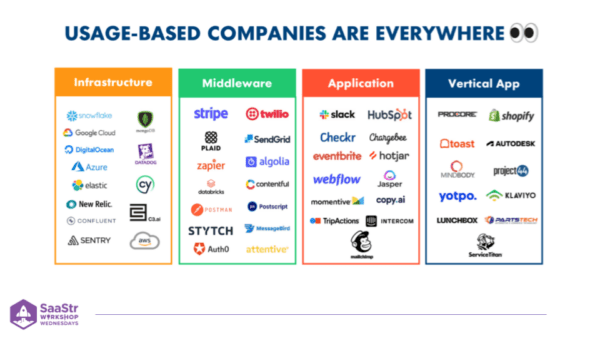
Measure Sales Impact Before Incentivizing It
Before getting into all the ways to incentivize, you need to think about being able to measure sales impact. This is something MongoDB puts a lot of work into internally and built into the product. They wanted to differentiate organic consumption from growth being driven by sales. Customers may be growing because their application is growing, but they don’t want to focus a rep on maintaining existing customers. Instead, the goal is to go out and find new workloads.
At MongoDB, they have a self-serve channel where they run a control group — a subset of accounts that they never touch, just to see what happens naturally. That way, they know what growth to expect and what incremental uplift they’re getting from having sales involved so they can continue to make better investments.
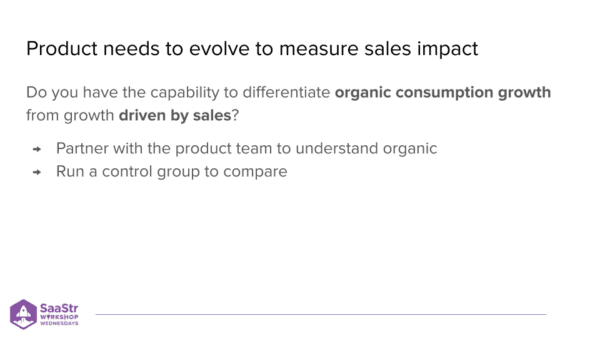
Compensate On What Reps Can Control
Compensation drives behavior, and you really want to compensate reps on what they can control. It’s frustrating as a sales rep to be compensated on something where you don’t think you can move the needle. In a consumption-oriented product, customers can fluctuate. Sometimes, that’s because of a sales rep’s involvement. Other times, it’s just macroeconomic conditions.
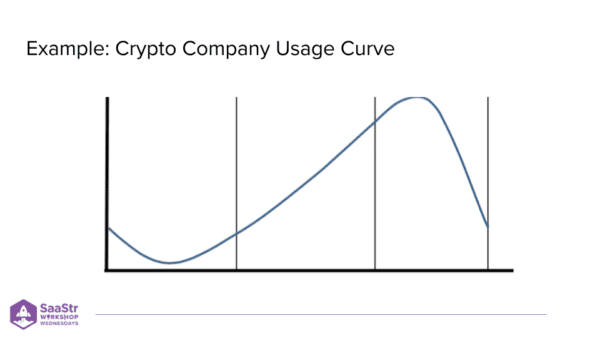
Imagine the made-up usage curve example above.
There’s a crypto company using the platform, and the past several years saw a large uptick because the market was booming. Then what happens? The crypto market stopped doing as well, so usage was down. It’s quite challenging to think through this in a consumption-based model. But we do know that incentives drive behavior. So, start with the behavior you want to drive.
Driving Market Acquisition
When designing a compensation plan, you have to decide what behaviors you want to drive. The first might be market acquisition. You want to land as many logos as possible. MongoDB initially took this approach — the logo team passed it to the expansion team. Rather than compensating based on ARR, it’s based on a volume and quality-based metric.
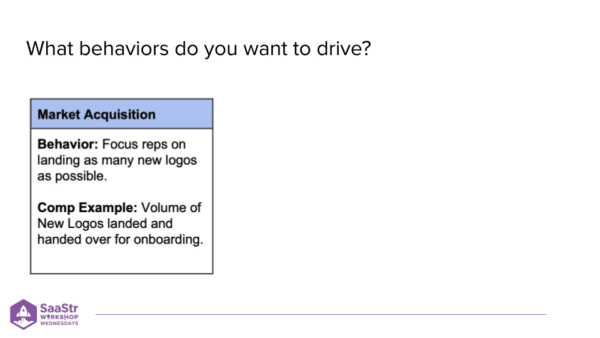
How do you incentivize this?
On a growth team, it’s overall ARR and on a unit basis (the number of new workloads of a certain quality). That means that a part of the ARR target is from organic growth coming anyway, and then you have to land a certain amount of new workloads. What are the pros and cons of measuring on a unit basis?
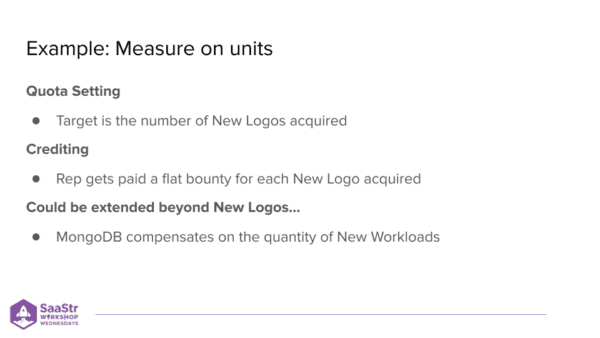
Pros:
- Dead simple comp plan
- Reps are laser-focused
- Drives high velocity and activity
Cons:
- It is harder for reps to overachieve on a unit-based plan
- Need to have criteria to ensure quality
You need to blend ARR and unit-based, or you’ll risk driving low-quality outcomes.
Driving Nurture & Growth
What if you want to focus on nurturing and growing your customers, driving product adoption, and cross-selling? In that world, you might want to measure the reps on gross billing with the customer and maybe even SPIFF on commitments and product-based SPIFFs. Crediting is simple because they’re credited for every dollar billed.
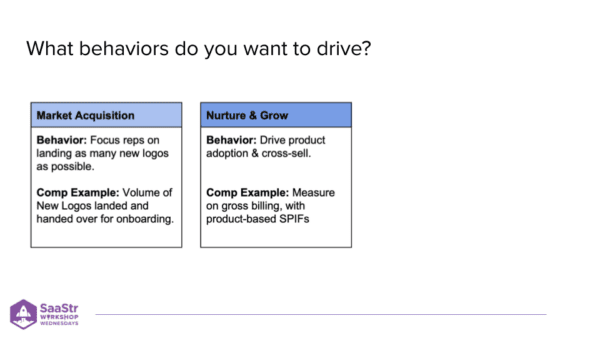
What are the pros and cons of measuring gross usage?
Pros:
- The rep, the company, and the customer are very aligned.
- Provides a consistent payout for the rep as the customer consumes
- Crediting is simple to understand
Cons:
- Getting quotas right is a challenge
- Reps are paid on retention
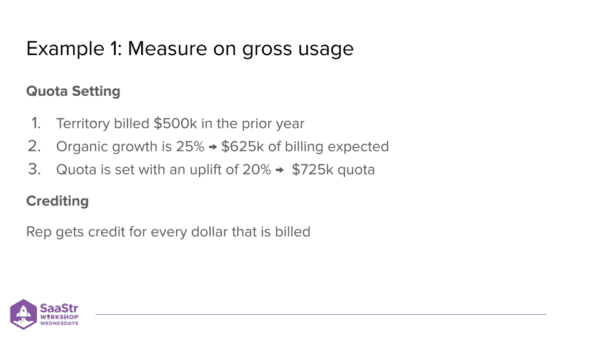
Growth expectations can be a bit of a “black box” to the reps. Companies have a growth expectation for every customer and can feel punitive to the rep (i.e., if you grow an account, your quota goes up.) Another tricky thing is how you align the sales team. In this approach, you’re paying a lot to reps for retention.
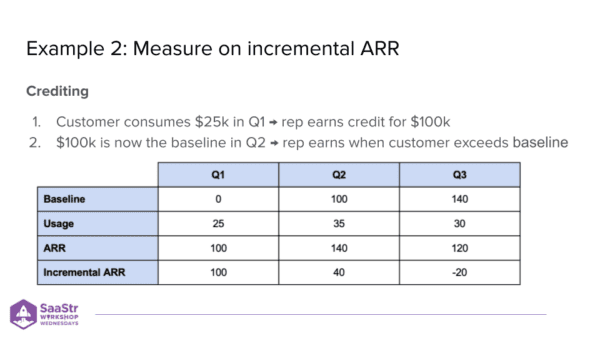
In the example above, their quota is to get to $725k billed. So, you’re essentially paying them for a $500k billing that already exists. Another way to nurture and grow is to measure on incremental ARR. At MongoDB, they wanted to neutralize whether a customer wanted to pay-as-you-go or make a commitment. They wanted reps to position pay-as-you-go and didn’t want them to slow down the sales cycle by forcing commitment unnecessarily. So, this idea of net ARR or incremental ARR was introduced, where the rep gets paid at the end of a quarter for the incremental usage above a baseline.
What are the pros and cons of measuring incremental ARR?
Pros:
- You’re only paying based on growth, which focuses the reps on driving new business
- Reps take more risk but get more upside
Cons:
- The challenge is it’s complicated to explain and operationalize
- Crediting can be negative, and reps hate that
This macroenvironment is tricky. Customers are focused on cost and cost optimization. So, if you’re measuring on incremental ARR, you create a large disincentive for a rep to talk to a customer about optimizing their environment… Because that means churn for them.
Driving Protective Behaviors
The last behavior might be protecting or taking a longer-term view. One compensation example is paying reps on commitment ACV. MongoDB de-incentivized this because the product is good, and they wanted reps to focus on getting as many workloads as possible and getting them consuming. It might be more competitive and secure revenue longer-term to put the commitment element on top of a compensation plan.
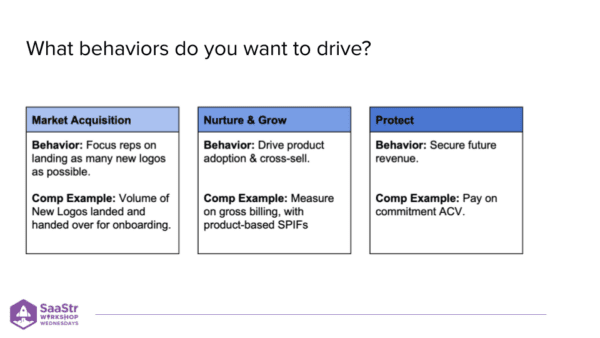
What are the pros and cons of a commitment approach?
Pros:
- Locks customers in
- Revenue is predictable
- Reps have control
Cons:
- Risk that reps oversell customers
- Can create friction in the sales cycle
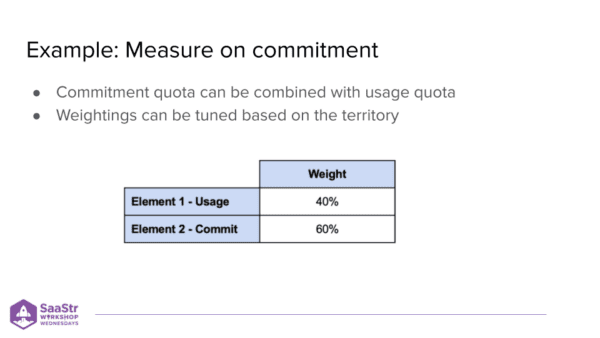
When you over-incentivize commitment, you oversell the customer. It’s not customer-friendly, and it’s challenging for customers to predict what they’ll use.
Key Takeaways
Consumption-based pricing requires rethinking your organization.
- What are the roles and responsibilities of sales, pre-sales, and post-sales? The lines will blur.
- Product: Needs to invest in tooling to support GTM teams.
The key principles for designing compensation plans are to:
- Always start with the behaviors you want to drive
- Measure reps on what they can control
The approaches for consumption-based compensation include:
- Unit-based — number of workloads or new logos
- Gross usage
- Incremental ARR
- Commitments

